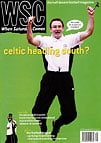 The Football League has suffered by comparison since the Premier League began. But, says Roger Titford, in many ways the lower echelons are in rude health
The Football League has suffered by comparison since the Premier League began. But, says Roger Titford, in many ways the lower echelons are in rude health
“Are you lot all still here?” Surprisingly, almost ten years after the hugely successful launch of the Premier League the remnant Football League is still going – all present and correct. The FA’s Blueprint for Football, which incorporated the essential ideas for the Premier League in 1991, said little and seemed to care less about life in the Football League in the new era. Prospects were “not encouraging” and “radical action” was needed, though the only measures suggested were the familiar ones: a reduction of four clubs, much ground-sharing and a return to regionalised lower divisions. This pessimism about the state of the Football League is still widely present among fans and the media today.
But the League has thus far proved durable. No club has gone out of business since 1992, despite the usual number of scrapes. In the face of all the media attention lavished on the Premiership, League gates are up by 30 per cent over the decade, with rises almost as large in the Third Division as the First. Last season ten League clubs, including Rochdale, Crewe and West Brom, had their highest average attendance for over 20 years. Altogether 18 Football League clubs play in all-seater stadiums that have held crowds of 20,000 plus – far more than was envisaged in the 1991 Blueprint. The League has resisted the temptation to introduce daft structural reforms merely for the sake of change.
Its clubs continue to make a mark in cup competitions, with Birmingham reaching the League Cup final and Wycombe the FA Cup semi-final last season. England still occasionally pick players from League clubs (eg Michael Gray and Kevin Phillips before Sunderland’s most recent promotion). Despite all its puffing, the Conference as a division is still well behind the Third Division and the only promoted Conference club to make a sustained mark on the Football League has been Wycombe.
Antiquated facilities and antediluvian boardroom attitudes are becoming the exception rather than the rule. The standard of play in the League’s mid-point, the Second Division, is distinctly higher than a decade ago. All in all, and despite the powerful Premier League presence, the Football League has made good progress since 1992.
The problem is, of course, that the top half of the Premiership has disappeared into the stratosphere. The Football League clubs have sustained two serious losses; a loss of engagement with the top of English football and a loss of “the Wimbledon phenomenon”. The loss of engagement is keenly felt in the lack of transfer activity between the two leagues (“they buy abroad now” and the lack of “real” cup ties (“they won’t put out their first team against us”). The gruesome tackle by Carlisle’s Richard Prokas on Patrick Vieira in last season’s FA Cup tie spoke volumes about the impotent rage felt by today’s journeyman footballer about the perceived untouchability of the stars.
Football League fans (don’t call us Nationwide fans) feel cut off from and disregarded by the top of the game. They feel that the media battle was badly lost by the League in the mid-Nineties. The scheduling of the Football Extra highlights package for the early hours of the morning summed that up – though the fact that it still attracts a decent audience is another indication of the League’s enduring appeal.
The other loss is the dream of top division football, doing a Northampton or a Carlisle or, best of all, a Wimbledon. Fans of some clubs have given that up as a pure delusion. But it can still happen for many League clubs, even if not in quite the same way: Bradford City came from nowhere to spend two seasons at the top; Fulham went from bottom to top division in five years. Further up the peck-ing order, Sunderland, Ipswich and Charlton appear to have transformed themselves into credible Premiership outfits.
The gap between the two leagues is bigger. More promoted teams do go straight down, but not that many more if you look at the maths rather than the myths. In short, somehow, the Football League rolls on – unsung. Its future, as always, is cloudy, but the fires of local passion still burn long and deep.
From WSC 175 September 2001. What was happening this month